
Uniforms & Insignia | Ranks & Organization | Misc. | Contact
The armed forces of the United States share a common system of officer insignia, using stars, eagles, leaves and bars to indicate rank. Most of the insignia are silver, but two are gold, and the gold insignia are junior to the silver. In most applications, gold is considered more valuable and thus "senior" to silver. How did the traditional positions of these two metals become inverted?
The explanation originates in the early 1800s with the US Army, which created the insignia system eventually adopted by the Marine Corps, Navy, Air Force and Coast Guard. Army uniforms of the time were not "uniform" by today's standards. Though ususally of dark blue cloth, different colors of facings and trim were used to distinguish various branches. One distinguishing feature was the metal used in buttons and metallic trim, which could be either silver or gold. One was not considered senior to the other, it was simply another way to differentiate the uniforms of the various components of the Army.
The principal way of indicating an officer's rank in the early 1800s was with the fringed shoulder epaulettes. By the 1830s, all officers wore an epaulette on each shoulder and a system of indicating rank had been established. Most of the Army wore gold buttons and epaulettes, except for the infantry regiments, which wore silver. Generals had stars and colonels had eagles on the epaulettes. For the sake of visibility, the contrasting metal was used for these devices, silver on gold and vice versa. The rest of the epaulettes were plain, with the ranks indicated by the thickness of the bullion fringe and, in the case of majors, by use of a contrasting epaulette strap. [Note: As the focus of this page is rank insignia, regimental numbers and staff insignia that were also worn on the epaulettes are omitted in the following illustrations.]
The epaulettes were expensive and cumbersome, and so were usually removed for service in the field. To indicate rank on field uniforms, a system of shoulder straps was authorized in 1836. These were derived from the rectangular loops on the shoulders of the coat that held the epaulettes in place.
The shoulder straps used a continuation of the "color scheme" from the epaulettes: Generals, colonels and majors used contrasting metals, while lieutenant colonels, captains and lieutenants used one or the other throughout.
Dragoon officers wore shoulder straps of a different design, similar to the shape of an epaulette but with a blue cloth background and no fringe, and with rank devices similar to those used on the rectangular straps.
|
|
|
|
|
|
| Major General Commanding the Army |
Major General | Brigadier General |
|
|
|
|
|
|
|
|
|
|
|
|
Colonel |
Lieutenant Colonel |
Major |
Captain |
1st Lieutenant |
2nd Lieutenant |
|
|
|
|
|
|
|
|
|
|
|
|
Colonel |
Lieutenant Colonel |
Major |
Captain |
1st Lieutenant |
2nd Lieutenant |
In 1851, Army regulations standardized gold as the "button metal" for the entire service, and officers of all branches were authorized gold epaulettes. Since the contrasting color would no longer be used to distinguish the major, the leaf from the lieutenant colonel's shoulder straps was introduced to the epaulette, in silver to contrast with the gold. The plain field officer's epaulette was left for majors. The bars of captains and first lieutenants also began to be used on the epaulettes, the plain junior officer's epaulette remaining for second lieutenants.
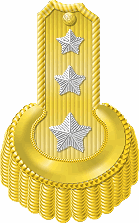
|
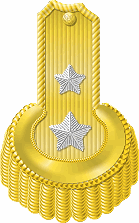
|
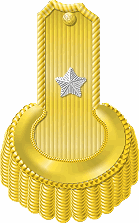
|
| Major General Commanding the Army | Major General | Brigadier General |
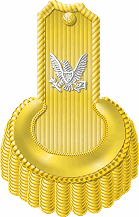
|
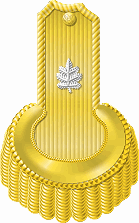
|
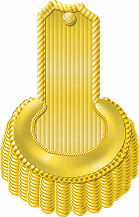
|
| Colonel | Lieutenant Colonel | Major |
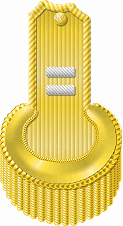
|
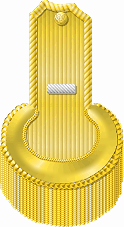
|
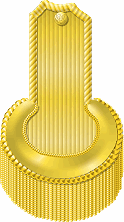
|
| Captain | 1st Lieutenant | 2nd Lieutenant |
The shoulder straps were revised as well in 1851. A gold border was standardized for all, and generals' and colonels' straps retained their contrasting devices. To correspond with the epaulettes, lieutenant colonels now wore silver leaves, in contrast with the border, and in turn majors' leaves were now gold. Unlike the epaulette insignia, however, captains' and first lieutenants' shoulder strap bars remained gold, the same as the border. This is possibly explained by the fact that the bars were usually made as segments of the same material as the border, and keeping the bars and border "in agreement" would simplify manufacture.
To distinguish the branches of the army, different colored backgrounds were introduced to the straps: Orange for dragoons, green for mounted riflemen, red for artillery, light blue for infantry, and dark blue for all other officers, grouped as "staff."

|

|

|
| Major General Commanding the Army | Major General | Brigadier General |

|

|

|
| Colonel (Infantry) |
Lieutenant Colonel (Staff) |
Major (Mounted Riflemen) |

|

|

|
| Captain (Artillery) |
1st Lieutenant (Dragoons) |
2nd Lieutenant (Infantry) |
In 1872, new regulations eliminated epaulettes for officers below brigadier general. In their place, officers wore gold cord shoulder knots. Because there was no longer any bullion fringe to distinguish the major and the second lieutenant, the major's gold leaf was used on the shoulder knots, and so appeared for the first time on full dress as well as undress uniforms.
Shoulder straps were also addressed in 1872: The bars of captains and first lieutenants were changed from gold to silver, corresponding with the bars on the dress shoulder knots and conforming to the pattern of the senior ranks. Thus all ranks below general had arrived at the insignia which is still used today, with one exception: second lieutenants continued to wear the shoulder strap without insignia.
Although not related to the silver/gold issue, another interesting aspect of the 1872 shoulder straps was that the insignia of the Army's only officer with the rank of general, William T. Sherman, were changed from four stars to two stars with the US coat of arms between.

|

|

|

|
| General | Lieutenant General | Major General | Brigadier General |

|

|

|
| Colonel (Staff) |
Lieutenant Colonel (Artillery) |
Major (Infantry) |

|

|

|
| Captain (Cavalry) |
1st Lieutenant (Artillery) |
2nd Lieutenant (Staff) |
By the time of the Spanish-American War, the Army had become conscious of the value of camouflage and stopped wearing blue uniforms in the field in favor of khaki and olive drab. Instead of the gold-bordered shoulder straps, the new service uniforms had cloth shoulder loops, buttoned at the neck end, with the rank device either embroidered or as a metal pin. Second lieutenants, with no authorized rank device, wore officer's uniform with plain shoulder loops.

|

|

|

|
| General | Lieutenant General | Major General | Brigadier General |

|

|

|
| Colonel | Lieutenant Colonel | Major |

|

|

|
| Captain | 1st Lieutenant | 2nd Lieutenant |
Ordinarily, there were enough uniform distinctions that officer status was readily apparent: the material of the uniform, collar devices, hat cords, sidearms and so on. But when the American Expeditionary Forces began serving in the trenches of the First World War, many of these features were abandoned in favor of a more practical wartime uniform, and the need for a rank device to distinguish the second lieutenant became apparent. Although a single silver bar was proposed, with two for first lieutenants and three for captains, it was decided to keep the existing insignia unchanged. Following the precedent of the majors' gold leaves, a War Department order of December 29, 1917 prescribed a single gold bar for second lieutenants. The same order changed the general's insignia to "such as he may prescribe," which in practice was four silver stars. In 1921 the general's insignia was set as four stars and the lieutenant general's larger star was changed to the same size as the other two. The Army's officer rank insignia had arrived at the final pattern that continues to the present day, with gold insignia ending up junior to the silver ones.

|
| 2nd Lieutenant, after December, 1917 |
Of the other services, the Marine Corps was the first to adopt the Army's officer insignia, with similar shoulder straps authorized around 1840, and usually followed the Army's insignia changes fairly quickly. In 1917, Marines were serving in Europe side by with Army units and were beginning to wear Army uniforms due to supply considerations, and so adopted the second lieutenant bar at the same time as the Army.
The navy had shoulder straps similar to the Army type, but did not use comparable insignia until 1862. At that time, the number of naval ranks was expanded to equal the number of Army grades, and the eagles, leaves and bars were introduced to navy shoulder straps. In 1869 the bars were changed from gold to silver, anticipating the change the Army would make in 1872. Shoulder straps were eliminated from naval officers' uniforms in 1913, and collar rank devices were suspended in 1919. In the Navy Uniform Regulations of 1922, the gold bar was prescribed for ensigns' full dress epaulettes, and eventually appeared on working uniforms when collar insignia were re-introduced in 1941. Coast Guard and Revenue Cutter Service officer insignia have followed the Navy's example since the Civil War.
The US Air Force, originating as a component of the Army, quite naturally kept the officers' rank insignia already in use when it became an independent service in 1947.
All text and images © Justin T. Broderick, 2013 unless otherwise indicated.